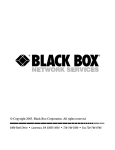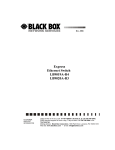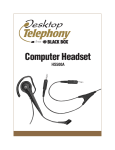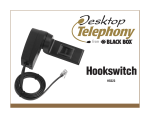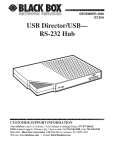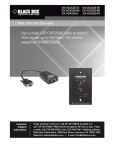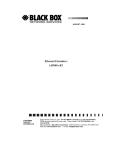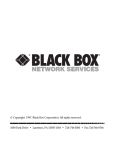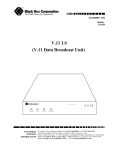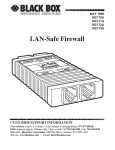Download © Copyright 2000. Black Box Corporation. All rights reserved.
Transcript
© Copyright 2000. Black Box Corporation. All rights reserved. 1000 Park Drive • Lawrence, PA 15055-1018 • 724-746-5500 • Fax 724-746-0746 OCTOBER 2000 SP143A-R2 V.35 Data Line Protector CUSTOMER SUPPORT INFORMATION Order toll-free in the U.S. 24 hours, 7 A.M. Monday to midnight Friday: 877-877-BBOX FREE technical support, 24 hours a day, 7 days a week: Call 724-746-5500 or fax 724-746-0746 Mail order: Black Box Corporation, 1000 Park Drive, Lawrence, PA 15055-1018 Web site: www.blackbox.com • E-mail: [email protected] FCC INFORMATION FEDERAL COMMUNICATIONS COMMISSION AND INDUSTRY CANADA RADIO FREQUENCY INTERFERENCE STATEMENTS This equipment generates, uses, and can radiate radio frequency energy and if not installed and used properly, that is, in strict accordance with the manufacturer’s instructions, may cause interference to radio communication. It has been tested and found to comply with the limits for a Class A computing device in accordance with the specifications in Subpart J of Part 15 of FCC rules, which are designed to provide reasonable protection against such interference when the equipment is operated in a commercial environment. Operation of this equipment in a residential area is likely to cause interference, in which case the user at his own expense will be required to take whatever measures may be necessary to correct the interference. Changes or modifications not expressly approved by the party responsible for compliance could void the user’s authority to operate the equipment. This digital apparatus does not exceed the Class A limits for radio noise emission from digital apparatus set out in the Radio Interference Regulation of Industry Canada. Le présent appareil numérique n’émet pas de bruits radioélectriques dépassant les limites applicables aux appareils numériques de la classe A prescrites dans le Règlement sur le brouillage radioélectrique publié par Industrie Canada. 1 V.35 DATA LINE PROTECTOR NORMAS OFICIALES MEXICANAS (NOM) ELECTRICAL SAFETY STATEMENT INSTRUCCIONES DE SEGURIDAD 1. Todas las instrucciones de seguridad y operación deberán ser leídas antes de que el aparato eléctrico sea operado. 2. Las instrucciones de seguridad y operación deberán ser guardadas para referencia futura. 3. Todas las advertencias en el aparato eléctrico y en sus instrucciones de operación deben ser respetadas. 4. Todas las instrucciones de operación y uso deben ser seguidas. 5. El aparato eléctrico no deberá ser usado cerca del agua—por ejemplo, cerca de la tina de baño, lavabo, sótano mojado o cerca de una alberca, etc.. 6. El aparato eléctrico debe ser usado únicamente con carritos o pedestales que sean recomendados por el fabricante. 7. El aparato eléctrico debe ser montado a la pared o al techo sólo como sea recomendado por el fabricante. 8. Servicio—El usuario no debe intentar dar servicio al equipo eléctrico más allá a lo descrito en las instrucciones de operación. Todo otro servicio deberá ser referido a personal de servicio calificado. 9. El aparato eléctrico debe ser situado de tal manera que su posición no interfiera su uso. La colocación del aparato eléctrico sobre una cama, sofá, alfombra o superficie similar puede bloquea la ventilación, no se debe colocar en libreros o gabinetes que impidan el flujo de aire por los orificios de ventilación. 10. El equipo eléctrico deber ser situado fuera del alcance de fuentes de calor como radiadores, registros de calor, estufas u otros aparatos (incluyendo amplificadores) que producen calor. 11. El aparato eléctrico deberá ser connectado a una fuente de poder sólo del tipo descrito en el instructivo de operación, o como se indique en el aparato. 2 NOM STATEMENT 12. Precaución debe ser tomada de tal manera que la tierra fisica y la polarización del equipo no sea eliminada. 13. Los cables de la fuente de poder deben ser guiados de tal manera que no sean pisados ni pellizcados por objetos colocados sobre o contra ellos, poniendo particular atención a los contactos y receptáculos donde salen del aparato. 14. El equipo eléctrico debe ser limpiado únicamente de acuerdo a las recomendaciones del fabricante. 15. En caso de existir, una antena externa deberá ser localizada lejos de las lineas de energia. 16. El cable de corriente deberá ser desconectado del cuando el equipo no sea usado por un largo periodo de tiempo. 17. Cuidado debe ser tomado de tal manera que objectos liquidos no sean derramados sobre la cubierta u orificios de ventilación. 18. Servicio por personal calificado deberá ser provisto cuando: A: El cable de poder o el contacto ha sido dañado; u B: Objectos han caído o líquido ha sido derramado dentro del aparato; o C: El aparato ha sido expuesto a la lluvia; o D: El aparato parece no operar normalmente o muestra un cambio en su desempeño; o E: El aparato ha sido tirado o su cubierta ha sido dañada. 3 V.35 DATA LINE PROTECTOR TRADEMARKS USED IN THIS MANUAL Velcro is a registered trademark of Velcro USA Inc. Any other trademarks mentioned in this manual are acknowledged to be the property of the trademark owners. 4 CONTENTS Contents Chapter Page 1. Specifications . . . . . . . . . . . . . . . . . . . . . . . . . . . . . . . . . . . . . . . . . . . . . 6 2. Introduction . . . . . . . . . . . . . . . . . . . . . . . . . . . . . . . . . . . . . . . . . . . . . . 7 3. Installation . . . . . . . . . . . . . . . . . . . . . . . . . . . . . . . . . . . . . . . . . . . . . . . 8 3.1 Placement Concerns. . . . . . . . . . . . . . . . . . . . . . . . . . . . . . . . . . . . . 8 3.2 Installing the Protector. . . . . . . . . . . . . . . . . . . . . . . . . . . . . . . . . . . 8 4. Troubleshooting . . . . . . . . . . . . . . . . . . . . . . . . . . . . . . . . . . . . . . . . . . . 9 4.1 Possible Problems . . . . . . . . . . . . . . . . . . . . . . . . . . . . . . . . . . . . . . . 9 4.2 Calling Black Box . . . . . . . . . . . . . . . . . . . . . . . . . . . . . . . . . . . . . . . 10 4.3 Shipping and Packaging. . . . . . . . . . . . . . . . . . . . . . . . . . . . . . . . . . 10 5 V.35 DATA LINE PROTECTOR 1. Specifications Interface — V.35 Maximum Data Rate — 10 Mbps Connectors — (1) 34-pin M-block male Leads/Signals Protected — All V.35 leads/signals Maximum Capacitance — Less than 40 pF Response Time — Less than 10 ns Maximum Surge Protection (Current, 8 x 20 µs at Standard Clamp Voltage) — 370 amps Standard Clamp Voltage — 30 volts Series Resistance — None Temperature — -58 to +212°F (-50 to +100°C) Humidity — 10 to 100% relative, noncondensing Size — 1.3"H x 3.3"W x 5.2"D (3.3 x 8.4 x 13.2 cm) plus 8" (20.3 cm) of cable (fully extended) on either side for a total length/depth of 21.2" (53.8 cm) Weight — 0.7 lb. (0.3 kg) 6 CHAPTER 2: Introduction 2. Introduction Electrical surges can hit telecommunication and computer devices through their power cords or power supplies. However, most people don’t realize that surges can strike through data lines as well. Surges can be generated when lightning strikes nearby, when someone crashes into a telephone pole, or even when fans, air conditioners, or elevators in your own building turn on or off. If a surge follows a data line or chassis ground into an unprotected device, it will result in data errors at best, probably a system error or lockup, and possibly permanent damage to the device and any attached networks. NOTE If you are passing V.35 signals using cables and devices with connectors other than 34-pin M-blocks, call Black Box at 724-746-5500. We might be able to provide you with special Protection Adapter Cables that have your kind of connectors. It might also be possible to use the Card-Edge Protector to protect some other type of interface (call Black Box Technical Support), but this interface should operate at less than 30 volts. These units will repeatedly redirect minor surges into ground, resetting themselves after each incident so that they’ll be ready for the next one. And if a unit is exposed to more than its rated energy (that is, if it is hit by a major surge too powerful to redirect), it will break the data-line circuit as it burns out, taking the attached device off line and preventing surge energy from reaching the device. NOTE No surge protector can protect your equipment from a direct lightning strike. Make sure your building is protected by lightning rods, and if you are running data lines between buildings at your site, avoid running them above ground outdoors. 7 V.35 DATA LINE PROTECTOR 3. Installation 3.1 Placement Concerns Where you put the Protector is critical to its ability to protect your equipment. Damage can occur if there is as little as 18 inches (45-cm) of wire between the Protector and the device you want to protect. For best results, keep the length of both signal wire and ground wire between the Protector and the device to a minimum. Do not add any length of wire to the Protector’s ground wire, which must be attached directly to the metal chassis of the device you want to protect. (Make sure the device’s chassis is attached to a properly grounded AC outlet.) If you add any signal wire between the Protector and the device, the total length of signal wire between the Protector and the device must not exceed 12 inches (30.5 cm). If you go beyond these length restrictions, the Protector will not effectively protect your equipment. If you need to mount your Protector on a wall or a piece of equipment or furniture, use the Velcro® buttons included in your package. 3.2 Installing the Protector Turn off and unplug the device you want to protect. If the data line is already attached to the device’s communication port, detach it. Now insert the Protector between the incoming data cable and the device’s communication port. Then attach the Protector’s grounding wire directly to the device’s metal chassis. The Protector is not polarity-sensitive. For applications in which both Protection adapter cables are the same gender, it doesn’t matter which Cable is connected to the device, although you will probably want to connect the Cable that’s on the same end of the Protector as the ground wire. You can now plug the device back in and turn it back on. Your Protector should now be ready to intercept surges. 8 CHAPTER 4: Troubleshooting 4. Troubleshooting 4.1 Possible Problems If your data line no longer functions properly after you insert a new Protector, check these things: • Is the device plugged in and turned on? Are the Protector’s signal wires and ground wire firmly attached to it? Is it configured and operating properly? Is its software (if any) configured and operating properly? • Is the data cable firmly attached to a device or cable at its other end? • Is the equipment that your device is trying to communicate with plugged in, turned on, operating properly, etc.? If you rule out any of these possibilities, call your supplier for technical support. If your data line has been operating properly with a Protector inserted, but you are suddenly unable to transmit anything across it, check these things: • Is your device still plugged in, turned on, operating properly, etc.? Are the Protector’s signal wires and ground wire firmly attached to it? • Is the equipment that your device is communicating with still plugged in, turned on, operating properly, etc.? If you rule out any of these possibilities, chances are that the Protector has been hit by a surge powerful enough to blow it out. Swap in a new Protector; if data now flows freely, the old Protector has done its job—it has been “fried,” sparing your device and network the impact of the surge. Use the new Protector and throw the old one away; also, test the attached device carefully to make sure that it has not been damaged by residual surge energy. 9 V.35 DATA LINE PROTECTOR 4.2 Calling Black Box If you determine that your Protector is malfunctioning, do not attempt to alter or repair it. Contact Black Box Technical Support at 724-746-5500. The problem might be solvable over the phone. Before you do, make a record of the history of the problem. Your supplier will be able to provide more efficient and accurate assistance if you have a complete description, including: • The nature and duration of the problem. • When the problem occurs. • The components involved in the problem. • Any particular application that, when used, appears to create the problem or make it worse. 4.3 Shipping and Packaging If you need to transport or ship a Protector: • Package it carefully. We recommend that you use the original container. • Before you ship a unit for repair or return, contact your Black Box at 724-7465500 to get a Return Materials Authorization (RMA) number. If you are returning the unit, make sure you include everything you received with it. 10














